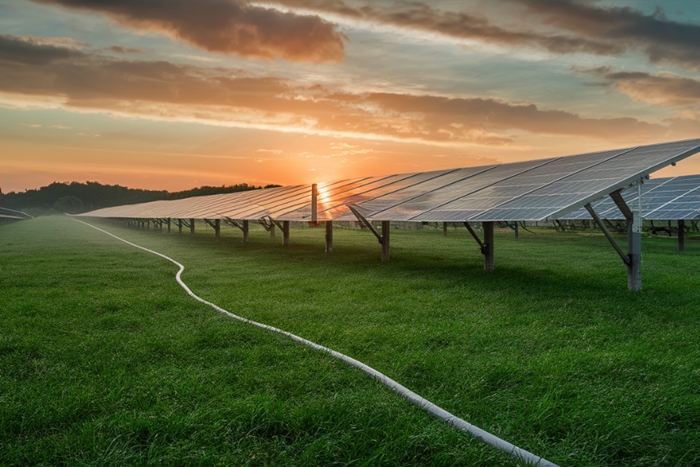nCa Report
Economization of water using the freely available solar energy – the idea is neat and very practicable. Just the thing Central Asia needs.
The EU and the UNDP, working together with the government of Uzbekistan, have introduced a drip irrigation system in the Akkurgan district of the Tashkent region, a region known for its low water supply.
According to UNDP, the system consists of a pump that pumps water from a 180-meter-deep well, using electricity from solar panels.
The device irrigates 0.8 hectares of land, benefiting 10 households and saving about 60% of water compared to traditional irrigation methods, reports Podrobno.uz.
The irrigation system is reported to have enough capacity to irrigate three hectares of land, which could benefit an additional 20 households. Also, excess electricity can be sold to the state electricity supply system.
The irrigation system using solar energy was created by an innovative group consisting of specialists from domestic institutions, in partnership with the Ministry of Agriculture and UNDP. It is funded by the European Union.
Apparently, the system is scalable and requires little maintenance.
The coupling of the sprinkler system with the solar energy is in vogue.
For anyone interested in experimenting with the idea, here is some useful information from KSNM Drip:
How To Use Solar-Powered Drip Irrigation System?
Solar-powered drip irrigation system is a boon for farmers, as they can harness the power of the sun and help you provide water to your crops. Here are simple steps that will help you know how to use a solar-powered drip irrigation system.
Components Required For A Solar Powered Drip Irrigation System
Without the proper components, it will be difficult for you to set up your solar-powered drip irrigation system. Here is a checklist for you on the components that are needed to set up your solar irrigation system with ease.
Solar Panels: Panels made out of photovoltaic material that helps in converting light into electricity. You need inverters and batteries to convert DC to AC and save it for later use.
Solar-Powered Water Pumps: A solar-powered water pump utilises sunlight to pump water, offering an eco-friendly solution for irrigation and water supply in remote areas without relying on electricity or fuel.
Drip Lines: Drip irrigation pipes from KSNM drip are made up of virgin polymer material, offering a long lifespan with UV protection.
Controllers: Controllers for our solar-powered pump and valves for drip irrigation system are a must to provide irrigation for the crops effectively.
How Solar Powered Drip Irrigation System Improve Agriculture?
Using Solar Power For Drip Irrigation
Place the solar panels in an area where they can receive ample sunlight throughout the day. Ensure that the panels are positioned at an angle to maximise exposure to sunlight.
Connect the solar panels to the pump of the drip irrigation system using the provided cables. Follow the manufacturer’s instructions carefully to ensure proper connection.
Lay out the drip tubing along the rows of plants or around the base of individual plants. Install drip emitters or drippers at appropriate intervals along the tubing to deliver water directly to the root zone of each plant.
Depending on the water requirements of your plants, adjust the flow rate of the drip emitters. This can be done by turning a valve on the drip irrigation system. Monitor the flow to ensure that each plant receives sufficient water without excess runoff.
Keep an eye on the solar panels to ensure they are generating enough power to operate the pump effectively. Clean the panels regularly to remove any dirt or debris that could reduce their efficiency.
Some solar-powered drip irrigation systems come with timers that allow you to schedule watering times. Set the timer according to the needs of your plants and the local climate.
Regularly check the drip tubing for leaks or clogs and replace any damaged or worn-out components as needed. Clean the filters and screens to prevent blockages and ensure proper water flow.
As the seasons change and the sunlight intensity varies, you may need to adjust the angle of the solar panels or the flow rate of the drip emitters to optimise performance.
By following these steps, you can effectively utilise a solar-powered drip irrigation system to water your plants efficiently while reducing water consumption and promoting healthy growth.
Is solar power irrigation system effective?
Yes, solar-powered irrigation systems for your farmland are effective in a lot of ways, like reducing the dependency on fossil fuels, decreasing operational costs and minimizing impact on the environment. You can also stop relying on power grids to provide energy to get water from your source. /// nCa, 22 August 2024
